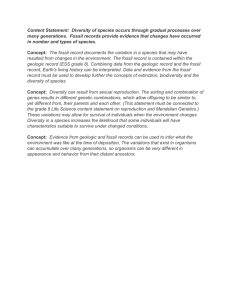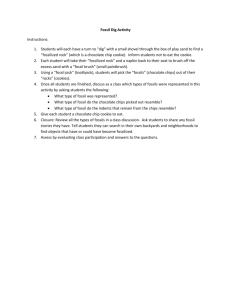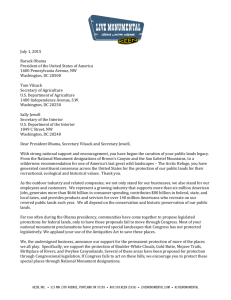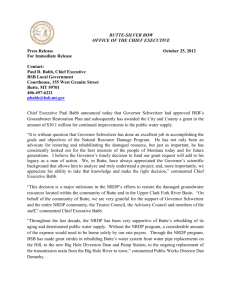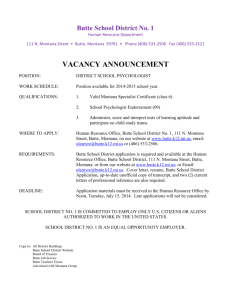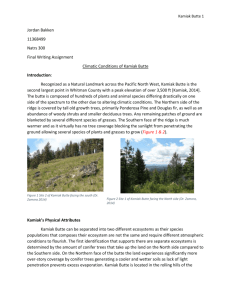Chapter Vocabulary Review
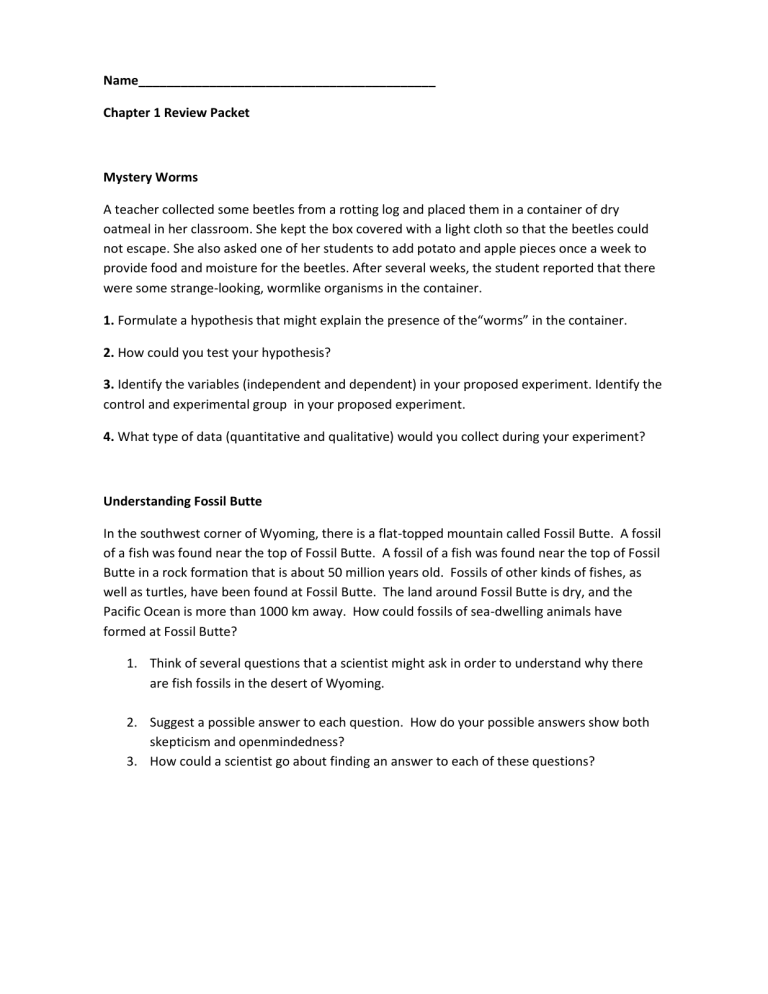
Name__________________________________________
Chapter 1 Review Packet
Mystery Worms
A teacher collected some beetles from a rotting log and placed them in a container of dry oatmeal in her classroom. She kept the box covered with a light cloth so that the beetles could not escape. She also asked one of her students to add potato and apple pieces once a week to provide food and moisture for the beetles. After several weeks, the student reported that there were some strange-looking, wormlike organisms in the container.
1. Formulate a hypothesis that might explain the presence of the“worms” in the container.
2. How could you test your hypothesis?
3. Identify the variables (independent and dependent) in your proposed experiment. Identify the control and experimental group in your proposed experiment.
4. What type of data (quantitative and qualitative) would you collect during your experiment?
Understanding Fossil Butte
In the southwest corner of Wyoming, there is a flat-topped mountain called Fossil Butte. A fossil of a fish was found near the top of Fossil Butte. A fossil of a fish was found near the top of Fossil
Butte in a rock formation that is about 50 million years old. Fossils of other kinds of fishes, as well as turtles, have been found at Fossil Butte. The land around Fossil Butte is dry, and the
Pacific Ocean is more than 1000 km away. How could fossils of sea-dwelling animals have formed at Fossil Butte?
1.
Think of several questions that a scientist might ask in order to understand why there are fish fossils in the desert of Wyoming.
2.
Suggest a possible answer to each question. How do your possible answers show both skepticism and openmindedness?
3.
How could a scientist go about finding an answer to each of these questions?
Do the following conversions and show all of your work. You may only use the conversion factors listed below.
60 seconds= 1minute 1 mile = 1.6 km 1 lb= 0.45 kg
60 minutes=1 hour
24 hours= 1 day
7 days= 1 week 1 inch = 2.54 cm
1.
How many seconds are you in school every week?
1 L =0.26 gallons
12 inches = 1 foot
2.
Joe and Mel are trying to determine whose car they should take down to Las Vegas (563 miles away). Joe’s tricked out Nissan Sentra Coupe gets 28 miles per gallon, while Mel’s
Cayman Porsche gets uses an average of 10 liters for every 100 km.
3.
The Pacific Giant Kelp is the longest growing kelp in the world at 197 ft long. How many millimeters (mm) is this? (Hint: For the last step use your metric conversion 1 cm =
___mm)
4.
The Pacific Giant Kelp grows at a rate of 18 in/day. How many centimeters per hour is this?
5.
Christopher Bergland holds the world record for most distance run on a treadmill in a day. He ran 247.45 km. How many miles per hour did Chris have to run to accomplish this?
6. The biggest piece of fudge ever created weighed 3010 lbs. The recommended serving of fudge is 28g. (28g = 1 serving) How many servings did this piece of fudge have?
Metric to Metric Conversion
1) 3.96 m= ___________cm
2) 58,290 cm =_________m
3) 2.98 m = __________mm
4) 306,300 mm =______m
11) 7.6 km =__________mm
12) 81,530 mm =_______________km
13) 31.43 L =____________mL
14) 81,580 mL =_____________L
5) 124.92 km =_________m
6) 281,500 m=_______km
7) 31.65 cm=__________mm
8) 12,738 mm=__________cm
9) 3.87 km=____________cm
10) 292,300 cm=______km
15) 3.21 g =____________mg
16) 41,340 mg=__________g
17) 60.24 kg= ________________g
18) 1540 g = ______________kg
19) 4.65 kg =______________mg
20) 145,600 mg = _____________kg
Chapter Vocabulary Review
For Questions 1
–8, complete each statement by writing the correct word.
1. The act of noticing and describing events or processes in a careful, orderly way is called .
2. The information gathered during an experiment is called .
3. A(n) is a logical interpretation based on what scientists already know.
4. A(n) is a scientific explanation for a set of observations that can be tested in ways that support or reject it.
5. A(n) is a well-tested explanation that unifies a broad range of observations and hypotheses.
6. In reproduction, the new organism has a single parent.
7. A(n) is a signal to which an organism responds.
8. is an organized way of gathering and analyzing evidence about the natural world.
For Questions 9
–17, write the letter of the definition that best matches each term on the line provided.
Term
9. biology
10. bias
11.
homeostasis
12.
metabolism
13.
14.
DNA
control group
15.
independent variable
16.
dependent variable
17 . biosphere
Definition
A. in an experiment, the group exposed to the same conditions as the experimental group except for one independent variable
B. the study of life
C. living things maintaining a relatively stable internal environment
D.
E.
a molecule containing the universal genetic code a point of view that is personal rather than scientific
F. a living planet
G. the combination of chemical reactions through which an organism builds up or breaks down materials
H. in an experiment, the variable that is manipulated
I.
in an experiment, the responding
variable




